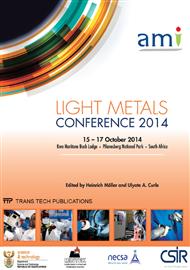[1]
E. Atar, E.S. Kayali, H. Cimenoglu, Characteristics and wear performance of borided Ti6Al4V alloy, Surf. Coat. Technol. 202 (2008) 4583–4590.
DOI: 10.1016/j.surfcoat.2008.03.011
Google Scholar
[2]
Y.S. Tian, C.Z. Chen, S.T. Li, Q.H. Huo, Research progress on laser surface modification of titanium alloys, Applied Surface Science 242 (2005) 177–184.
DOI: 10.1016/j.apsusc.2004.08.011
Google Scholar
[3]
O.N. Çelik, Microstructure and wear properties of WC particle reinforced composite coating on Ti6Al4V alloy produced by the plasma transferred arc method, Appl. Surf. Sci., 274 (2013) 334– 340.
DOI: 10.1016/j.apsusc.2013.03.057
Google Scholar
[4]
A. Amanov, I. Cho, D. Kim, Y. Pyun, Fretting wear and friction reduction of CP titanium and Ti–6Al–4V alloy by ultrasonic nanocrystalline surface modification, Surf. Coat. Technol. 207 (2012) 135–142.
DOI: 10.1016/j.surfcoat.2012.06.046
Google Scholar
[5]
EHKT Technologies, Opportunities for low cost titanium in reduced fuel consumption, improved emissions, and enhanced durability heavy-duty vehicles, Oak Ridge National Laboratory Report, ORNL/Sub/4000013062/1, Oak Ridge, Tennessee (2002) 59.
DOI: 10.2172/814648
Google Scholar
[6]
J. Qu, P.J. Blau, T.R. Watkins, O.B. Cavin, N.S. Kulkarnia, Friction and wear of titanium alloys sliding against metal, polymer, and ceramic counterfaces, Wear 258 (2005) 1348–1356.
DOI: 10.1016/j.wear.2004.09.062
Google Scholar
[7]
A. Bandyopadhyay, V.K. Balla, M. Roy, S. Bose, Laser surface modification of metallic biomaterials, JOM 63 (2011) 94–99.
DOI: 10.1007/s11837-011-0099-x
Google Scholar
[8]
E. Chikarakara, S. Naher, D. Brabazon, High speed laser surface modification of Ti-6Al-4V, Surf. Coat. Technol. 206 (2012) 3223–3229.
DOI: 10.1016/j.surfcoat.2012.01.010
Google Scholar
[9]
V.K. Balla, S. Soderlind, S. Bose, A. Bandyopadhyay, Microstructure, mechanical and wear properties of laser surface melted Ti6Al4V alloy, J. Mech. Beh. Biomed. Mat. 32 (2014) 335–344.
DOI: 10.1016/j.jmbbm.2013.12.001
Google Scholar
[10]
M. Atapour, A. Pilchak, G.S. Frankel, J.C. Williams, M.H. Fathi, M. Shamanian, Corrosion behaviour of Ti-6Al-4V with different thermomechanical treatments and microstructures, Corr. 66 (2010) 065004-065004-9.
DOI: 10.5006/1.3452400
Google Scholar
[11]
F.X. Gil Mur, D. Rodríguez, J.A. Planell, Influence of tempering temperature and time on the α'-Ti-6Al-4V martensite, J. Alloys Comp. 234 (1996) 287-289.
DOI: 10.1016/0925-8388(95)02057-8
Google Scholar
[12]
A.W. J DeGee, J.H. Zaat, Wear of copper alloys against steel in oxygen and argon, Wear 5 (1962) 257-274.
DOI: 10.1016/0043-1648(62)90129-1
Google Scholar


